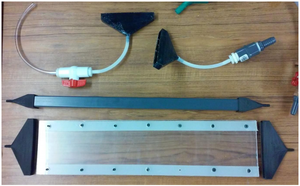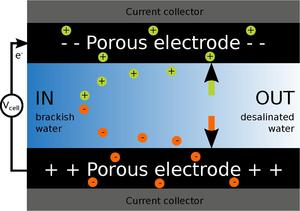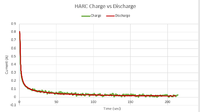Desalinator
| Square and HARC channels | |
| Sponsors | |
| Team Name | Saline Solution |
| Duration | Fall 2015 - Spring 2016 |
| Faculty Advisors | |
| Mentor |
|
| Students |
|
With an increasing need for fresh water, new low-energy and cost-efficient green technology to extract salt from water has become attractive. Our team uses electrical fields and high surface area nanomaterials to create a lossy capacitor that separates the sodium and chlorine ions.
Problem Definition[edit | edit source]
Background[edit | edit source]
Severe droughts in many parts of the world along with demands for fresh water have led to groundwater depletion . Approximately 71% of the world is covered by water but unfortunately, 96.5% of that water is undrinkable. Current methods of desalination use large amounts of energy. A device that can produce fresh water from seawater or reduce its salinity at a lower cost compared to current methods would ease many of these problems.
Deliverables[edit | edit source]
- Mathematical models for predicting ion motion in brine under magnetic and/or electrical field
- Extensive measurements on brine flows in channel/pipe under magnetic and/or electrical field
- Extensive measurements on the patent-pending prototype machine
- 15% reduction in salinity with a decent flow rate
- Measurement of energy required to create that reduction in salinity
Specifications[edit | edit source]
This project doesn't have specifications for a final design. Rather, this project has been a series of experiments designed to develop specifications for a final prototype and process.
Project Learning[edit | edit source]
Client Interview[edit | edit source]
- Wrote a list of technical, budget, and miscellaneous questions for client to make sure we approached this project fitting our client's needs
- From the answers we obtained, we were able to build a better foundation for starting this project
Lead Instructor and Technical Advisor Meetings[edit | edit source]
- Every week
- Topics such as due dates, technical progress, budgets, and brainstorming are all discussed during these meetings
Capacitive Deionization[edit | edit source]
An electric potential is applied to carbon electrodes across a brine filled channel.
There are currently 4 different process types that use forms of Capacitive deionization. These are:
- Flow-by mode in which brine water flows through a channel or channels that have charged electrodes as walls. This mode is simple to construct and model but has an inefficient discharge method.
- Flow-through mode in which brine can flow directly through porous electrodes. A more complex method that requires porous electrodes.
- Flow-electrode CDI is a type of continuous CDI in which a membrane separates the brine from a charged, moving mixture. This method is complex.
- CDI with wires is a type of continuous CDI in which wires are placed in a brine solution, charged, and then discharged in a different solution. This method is also complex and involves moving parts.
The most simple method (flow-by) is the one used for this project
Mathematical Model[edit | edit source]
This shows the equations used in our model to calculate the expected reduction of salinity. These equations used the geometry of the channel and electrodes along with the applied voltage to calculate how much charge (Qelectrode) could be collected on each electrode. This picture links to an article about water properties that was used.
Prototype Designs[edit | edit source]
| Prototype 1 | Description | Testing Results |
|---|---|---|
|
| |
| Prototype 2 | Description | Testing Results |
|
||
| Prototype 3 (HARC) | Description | Testing Results |
|
Team Information[edit | edit source]
| Jessica Drouin | Interests: Mechanics, Thermodynamics, Fluids, and Computer Aided Design |
| Mechanical Engineering | |
| Email: drou6296@vandals.uidaho.edu | |
| Essa Essa | Interests: Power, Electronics, Distribution Systems, Latest technology. |
| Electrical Engineering | |
| Email: essa0445@vandals.uidaho.edu | |
| Cody Moldenhauer | Interests: Power systems, Alternative energy, Latest technology. |
| Electrical Engineering | |
| Email: mold4329@vandals.uidaho.edu | |
| Ryan Ready | Interests: Power generation and distribution, Alternative energy, Archaeology, and many others. |
| Electrical Engineering | |
| Email: read6404@vandals.uidaho.edu | |
| Kevin Woodruff | Interests: Mechanics, Fluids, Machine Component Design, Stress Analysis, Data Acquisition. |
| Mechanical Engineering | |
| Email: wood9725@vandals.uidaho.edu |










